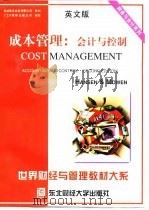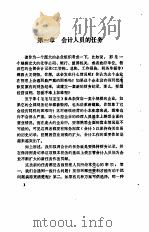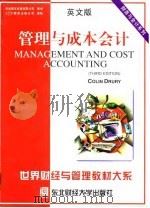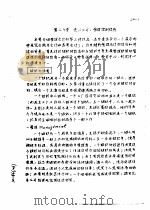《成本管理 会计与控制 第2版》
| 作者 | (美)唐·R.汉森(DonR.Hansen),玛丽安妮·M. 编者 |
|---|---|
| 出版 | 沈阳:东北财经大学出版社 |
| 参考页数 | 1032 |
| 出版时间 | 1998(求助前请核对) 目录预览 |
| ISBN号 | 781044378X — 求助条款 |
| PDF编号 | 810010528(仅供预览,未存储实际文件) |
| 求助格式 | 扫描PDF(若分多册发行,每次仅能受理1册) |

1 Introduction to Cost Accounting and Cost Management1
1 Introduction to Cost Accounting and Cost Management1
FINANCIAL,MANAGEMENT,AND COST ACCOUNTING2
Early Accounting Systems3
THE EVOLUTION OF ACCOUNTING3
Accounting in the Twentieth Century4
Total Quality Management6
Customer Orientation6
EMERGING THEMES IN COST ACCOUNTING6
Advances in Information Technology7
Time as a Competitive Element7
Advances in the Manufacturing Environment8
Growth of the Service Industry10
Global Competition10
A SYSTEMS APPROACH10
COST MANAGEMENT-A CROSS-FUNCTIONAL PERSPECTIVE12
THE ROLE OF TODAY S COST AND MANAGEMENT ACCOUNTANT13
The Need for Flexibility13
Behavioral Impact of Cost Information13
Information for Planning,Controlling,and Decision Making14
Line and Staff Positions14
ACCOUNTING AND ETHICAL CONDUCT16
Ethical Behavior16
Standards of Ethical Conduct for Management Accountants17
Ethical Conduct19
CERTIFICATION20
The CMA20
The CPA20
The CIA21
2 Basic Cost Management Concepts30
Part1 Fundamental Cost Management Concepts30
■2 Basic Cost Management Concepts30
A SYSTEMS FRAMEWORK31
Accounting Information Systems31
Relationship to Other Operational Systems and Functions34
Different Systems for Different Purposes36
COST ASSIGNMENT:DIRECT TRACING,DRIVER TRACING,AND ALLOCATION37
Cost Objects37
Accuracy of Assignments38
PRODUCT AND SERVICE COSTS42
Different Costs for Different Purposes42
Product Costs and External Financial Reporting43
EXTERNAL FINANCIAL STATEMENTS46
Income Statement:Manufacturing Firm46
Income Statement:Service Organization48
ACTIVITY DRIVERS AND COST BEHAVIOR48
Cost Behavior Concepts48
Fixed Costs50
■22 Productivity:Measurement and Control51
Variable Costs52
Mixed Costs54
TRADITIONAL AND CONTEMPORARY COST MANAGEMENT SYSTEMS55
Traditional Cost Management Systems:A Brief Overview55
Contemporary Cost Management Systems:A Brief Overview56
Choice of a Cost Management System58
■3 Activity Cost Behavior80
3 Activity Cost Behavior80
COST BEHAVIOR AND THE RESOURCE USAGE MODEL81
Time Horizon81
Activities,Resource Usage,and Cost Behavior82
Measures of Activity Output84
Step-Cost Behavior84
Activities and Mixed Cost Behavior87
METHODS FOR SEPARATING MIXED COSTS INTO EIXED AND VARIABLE COMPONENTS88
The High-Low Method89
Scatterplot Method91
The Method of Least Squares94
RELIABILITY OF COST FORMULAS96
Hypothesis Test of Parameters97
Goodness-of-Fit Measures97
Confidence Intervals100
MULTIPLE REGRESSION101
MANAGERIAL JUDGMENT103
4 Product and Service Costing:Overhead Application and Job-Order System126
■4 Product and Service Costing:Overhead Application and Job-Order System126
Part2 Cost Accounting Systems126
CHARACTERISTICS OF THE PRODUCTION PROCESS127
Manufacturing Firms Versus Service Firms127
Unique Versus Standardized Products and Services130
Cost Accumulation131
SETTING UP THE COST ACCOUNTING SYSTEM131
Cost Measurement132
Cost Assignment135
OVERHEAD APPLICATION:A NORMAL COSTING VIEW136
Predetermined Overhead Rates136
Choosing the Activity Base137
Choosing the Activity Level138
The Basic Concept of Overhead Application139
Disposition of Overhead Variances141
THE JOB-ORDER COSTING SYSTEM:GENERAL DESCRIPTION143
Overview of the Job-Order Costing System143
Materials Requisitions144
Job Time Tickets146
Overhead Application146
Unit Cost Calculation147
JOB-ORDER COSTING:SPECIFIC COST FLOW DESCRIPTION147
Accounting for Materials147
Accounting for Direct Labor Cost148
Accounting for Overhead149
Accounting for Finished Goods151
Accounting for Cost of Goods Sold153
Accounting for Nonmanufacturing Costs154
SINGLE VERSUS MULTIPLE OVERHEAD RATES155
APPENDIX:ACCOUNTIGN FOR SPOILAGE IN A TRADITIONAL JOB ORDER SYSTEM158
■5 Product and Service Costing:A Process Systems Approach180
5 Product and Service Costing:A Process Systems Approach180
PROCESS COSTING SYSTEMS:BASIC OPERATIONAL AND COST CONCEPTS181
Cost Flows181
The Production Report184
Unit Cost184
Service Organizations185
PROCESS COSTING WITH NO WORK IN PROCESS INVENTORIES185
JIT Manufacturing Firms186
PROCESS COSTING WITH ENDING WORK IN PROCESS INVENTORIES187
Equivalent Units as Output Measures187
Cost of Production Report Illustrated188
Nonuniform Application of Productive Inputs189
Beginning Work in Process Inventories190
FIFO COSTING METHOD191
Step3:Computation of Unit Cost192
Step4:Valuation of Inventories192
Step1:Physical Flow Analysis192
Step 2:Calculation of Equivalent Units192
Step5:Cost Reconciliation194
Journal Entries194
WEIGHTED AVERAGE COSTING METHOD196
Step1:Physical Flow Analysis196
Step2:Calculation of Equivalent Units197
Step3:Computation of Unit Cost197
Step4:Valuation of Inventories197
Production Report198
Step5:Cost Reconciliation198
FIFO Compared With Weighted Average198
TREATMENT OF TRANSFERRED-IN GOODS200
Step1:Physical Flow Schedule201
Step2:Calculation of Equivalent Units202
Step3:Computation of Unit Costs202
Step4:Valuation of Inventories202
OPERATION COSTING203
Basics of Operations Costing204
Operation Costing Example205
APPENDIX:SPOILED UNITS208
■6 Support Department Cost Allocation231
6 Support Department Cost Allocation231
AN OVERVIEW OF COST ALLOCATION232
Types of Departments232
Types of Allocation Bases234
OBJECTIVES OF ALLOCATION235
ALLOCATING ONE DEPARTMENT S COSTS TO ANOTHER DEPARTMENT237
A Single Charging Rate238
Dual charging Rates238
Budgeted Versus Actual Usage240
Fixed Versus Variable Bases:A Note of Caution242
CHOOSING A SUPPORT DEPARTMENT COST ALLOCATION METHOD243
Direct Method of Allocation244
Sequential Method of Allocation245
Reciprocal Method of Allocation246
Comparison of the Three Methods250
DEPARTMENAL OVERHEAD RATES AND PRODUCT COSTING251
7 Joint Product and By-product Costing268
■7 Joint Product and By-product Costing268
GENERAL CHARACTERISTICS OF JOINT PRODUCTION269
Cost Separability and the Need for Allocation270
Distinction and Similarity Between Joint Products and Byproducts271
Examples of Joint Products and By-prod-ucts272
ACCOUNTING FOR JOINT PRODUCT COSTS273
Benefits-Received Approaches273
Allocation Based on Relative Market Value276
ACCOUNTING FOR BY-PRODUCTS279
Noncost Methods of Accounting for By-products280
Cost Methods of Accounting for By-products281
Output Decisions282
EFFECT OF JOINT PRODUCT COSTS ON COST CONTROL AND DECISION MAKING282
Pricing Joint Products283
Further Processing Decisions283
Pricing Based on Cost of Further Production284
JOINT PRODUCTION OF SERVICES285
Contemporary Cost Accounting285
■8 Activity-Based Costing300
8 Activity-Based Costing300
Contemporary Cost Accounting300
LIMITATIONS OF TRADITIONAL COST ACCOUNTING SYSTEMS301
Plantwide and Departmental Rates301
The Inadequacy of Plantwide and Departmental Rates303
An Example Illustrating the Failure of Unit-Based Overhead Rates305
ACTIVITY-BASED PRODUCT COSTING:GENERAL DESCRIPTION308
First-Stage Procedure309
Second-Stage Procedure311
Comparison of Traditional and ABC Product Costs312
ABC and Service Organizations312
ACTIVITY IDENTIFICATION AND CLASSIFICATION315
Activity Identification315
Classification of Activities316
Comparison with Traditional Costing320
An Illustrative Example320
Homogeneous Sets:Necessary or Not?322
ABC DATA BASE324
ASSIGNING COSTS TO ACTIVITIES326
■9 Strategic Cost Management,Life Cycle Cost Management,and JIT353
9 Strategic Cost Management,Life Cycle Cost Management,and JIT353
STRATEGIC COST MANAGEMENT354
Creating and Sustaining a Competitive Advantage354
Value-Chain Framework,Linkages,and Activities355
Value-Chain Analysis359
LIFE CYCLE COST MANAGEMENT365
Product Life Cycle Viewpoints365
Interactive Viewpoint367
Role of Target Costing371
Short Life Cycles372
JUST-IN-TIME(JIT) MANUFACTURING AND PURCHASING372
Inventory Effects373
Plant Layout374
Grouping of Employees376
Employee Empowerment376
Total Quality Control376
JIT and Automation377
JIT AND TTS EFFECT ON THE COST MANAGEMENT SYSTEM378
Traceability of Overhead Costs378
Product Costing378
JIT s Effect on Job-Order and Process Costing Systems380
Backflush Costing380
■10 Cost-Volume-Profit Analysis410
10 Cost-Volume-Profit Analysis410
Part3 Decision Making:Traditional and Contemporary Approaches410
THE BREAK-EVEN POINTS IN UNITS411
Operating-Income Approach412
Contribution-Margin Approach413
Profit Targets413
After-Tax Profit Targets415
BREAK-EVEN POINT IN SALES DOLLARS416
Profit Targets419
Comparison of the Two Approaches420
MULTIPLE-PRODUCT ANALYSIS420
Break-even Point in Units420
Sales Dollars Approach423
GRAPHICAL REPRESENTATION OF CVP RELATIONSHIPS424
The Profit-Volume Graph424
The Cost-Volume-Profit Graph426
Assumptions of Cost-Volume-Profit Analysis427
CHANGES IN THE CVP VARIABLES429
Introducing Risk and Uncertainty431
Sensitivity Analysis and CVP433
CVP ANALYSIS AND ACTIVITY-BASED COSTING434
Example Comparing Conventional and ABC Analysis435
Strategic Implications:Conventional CVP Analysis Versus ABC Analysis436
CVP Analysis and JIT437
■11 Activity Resource Usage Model and Relevant Costing:Tactical Decision Making463
11 Activity Resource Usage Model and Relevant Costing:Tactical Decision Making463
The Tactical Decision-Making Process464
TACTICAL DECISION MAKING464
Qualitative Factors466
RELEVANT COSTS AND REVENUES468
Relevant Costs Illustrated468
Irrelevant Costs Illustrated468
RELEVANCY,COST BEHAVIOR,AND THE ACTIVITY RESOURCE USAGE MODEL469
Resources Acquired as Used and Needed469
Resources Acquired in Advance(Short Term)470
Resources Acquired in Advance (Multiperiod Service Capacity)471
ILLUSTRATIVE EXAMPLES OF TACTICAL DECISION MAKING471
Make-or-Buy Decisions471
Keep-or-Drop Decisions475
Special-Order Decisions478
Decisions to Sell or Process Further480
Relevant Costing and Ethical Behavior482
12 Capital Investment Decisions502
■12 Capital Investment Decisions502
TYPES OF CAPITAL INVESTMENT DECISIONS503
NONDISCOUNTING MODELS505
Payback Period505
Accounting Rate of Return507
DISCOUNTING MODELS:THE NET PRESENT VALUE METHOD508
NPV Defined508
An Example Illustrating Net Present Value509
INTERNAL RATE OF RETURN509
Example:Multiple-Period Setting with Uniform Cash Flows511
Multiple-Period Setting:Uneven Cash Flows511
MUTUALLY EXCLUSIVE PROJECTS512
NPV Compared with IRR512
Example:Mutually Exclusive Projects514
Capital Investment and Ethical Lssues515
COMPUTATION AND ADJUSTMENT OF CASH FLOWS516
Adjusting Forecasts for Inflation517
Conversion of Gross Cash Flows to After-Tax Cash Flows517
CAPITAL INVESTMENT:THE CONTEMPORARY MANUFACTURING ENVIRONMENT524
How Investment Differs525
How Estimates of Operating Cash Flows Differ525
Salvage Value528
Discount Rates529
APPENDIX A:PRESENT VALUE CONCEPTS530
Future Value530
Present Value531
13 Inventory Management:Economic Order Quantity,JIT,and the Theory of Constraints550
■13 Inventory Management:Economic Order Quantity,JIT,and the Theory of Constraints550
BASICS OF TRADITIONAL INVENTORY MANAGEMENT551
Traditional Reasons for Holding Inventory552
Economic Order Quantity:The Traditional Inventory Model553
Computing the EOQ554
Reorder Point554
Demand Uncertainty and the Reorder Point554
A Manufacturing Example556
EOQ and Inventory Management556
JIT AND INVENTORY MANAGEMENT:A DIFFERENT VIEW557
A Pull System558
Setup and Carrying Costs:The JIT Approach559
Due-Date Performance:The JIT Solution560
Avoidance of Shutdown and Process Reliability:The JIT Approach560
Discounts and Price Increases:JIT Purchasing Versus Holding Inventories564
JIT s Limitations564
BASIC CONCEPTS OF CONSTRAINED OPTIMIZATION565
One Binding Internal Constraint566
Internal Binding Constraint and External Binding Constraint566
Multiple Internal Binding Constraints567
THEORY OF CONSTRAINTS570
Basic Concepts570
Five-Step Approach571
■14 Pricing and Revenue Analysis589
14 Pricing and Revenue Analysis589
Customer Demand590
BASIC ECONOMIC PRICING CONCEPTS590
Price Elasticity of Demand591
Market Structure and Price593
COST-BASED PRICING595
TARGET COSTING AND PRICING597
LIFE CYCLE PRICING599
Development Stage599
Introduction Stage600
Growth Stage600
Decline Stage601
PRICES AND CONTROL601
Sale Price and Price Volume Variances601
Maturity Stage601
Other Methods of Evaluating Revenue602
LEGAL SYSTEM,ETHICS,AND PRICING602
Predatory Pricing603
Price Discrimination604
Fairness and Pricing607
■15 Profitability Analysis619
15 Profitability Analysis619
REASONS FOR MEASURING PROFIT620
MEASURES OF PROFIT621
Absorption Costing Approach to Measuring Profit621
Variable Costing Approach to Measuring Profit624
ANALYSIS OF PROFIT-RELATED VARIANCES627
Contributin Margin Variance627
Market Share and Size Variances629
PROFITABILITY OF SEGMENTS630
Profit by Product Line630
Divisional Profit634
Customer Profitability635
Overall Profit640
TIME AND PROFIT640
Short-Run Profitability641
Long-Run Profitability641
THE PRODUCT LIFE CYCLE642
Behavioral Decision Theory644
THE IMPACT OF PROFIT ON BEHAVIOR644
Ethics646
LIMITATIONS OF PROFIT MEASUREMENT647
16 Budgeting for Planning and Control676
Part4 Cost Planning and Control Systems676
■16 Budgeting for Planning and Control676
THE ROLE OF BUDGETING IN PLANNING AND CONTROL677
Purposes of Budgeting677
The Budgeting Process678
Gathering Information for Budgeting680
PREPARING THE OPERATING BUDGET683
PREPARING THE FINANCIAL BUDGET689
The Cash Budget690
Static Budgets Versus Flexible Budgets694
USING BUDGETS FOR CONTROL694
The Behavioral Dimension of Budgeting698
Operating Budgets for Merchandising and Service Firms703
Zero-Base Budgeting703
OTHER TYPES OF BUDGETS703
■17 Standard Costing:A Traditional Control Approach727
17 Standard Costing:A Traditional Control Approach727
UNIT STANDARDS728
How Standards Are Developed728
Types of Standards729
Why Standard Cost Systems Are Adopted729
STANDARD PRODUCT COSTS730
VARIANCE ANALYSIS:GENERAL DESCRIPTION733
Price and Efficiency Variances733
The Decision to Investigate733
VARIANCE ANALYSIS AND ACCOUNTING:MATERIALS AND LABOR735
Direct Materials Price and Usage Variances735
Direct Labor Variances740
Disposition of Materials and Labor Variances743
VARIANCE ANALYSIS:OVERHEAD COSTS744
Four-Variance Method:Variable Overhead Variances745
Four-Variance Analysis:Fixed Overhead Variances749
Total Fixed Overhead Variance749
Two-and Three Variance Analyses753
MIX AND YIELD VARIANCES:MATERIALS AND LABOR754
Materials Mix and Yield Variances755
Labor Mix and Yield Variances757
■18 Decentralization:Responsibility Accounting,Performance Evaluation,and Transfer Pricing774
18 Decentralization:Responsibility Accounting,Performance Evaluation,and Transfer Pricing774
RESPONSIBILITY ACCOUNTING775
Types of Responsibility Centers775
DECENTRALIZATION776
Reasons for Decentralization776
The Role of Information and Accountability776
The Units of Decentralization778
MEASURING THE PERFORMANCE OF INVESTMENT CENTERS778
Return on Investment779
Residual Income783
Economic Value Added785
Multiple Measures of Performance788
Incentive Pay for Managers-Encouraging Goal Congruence789
Managerial Rewards789
MEASURIGN AND REWARDING THE PERFORMANCE OF MANAGERS789
TRANSFER PRICING792
The Impact of Transfer Pricing on Income792
The Transfer Pricing Problem793
SETTING TRANSFER PRICES794
Market Price794
Negotiated Transfer Prices795
Cost-Based Transfer Prices801
19 International Issues in Cost Management819
■19 International Issues in Cost Management819
MANAGEMENT ACCOUNTING IN THE INTERNATIONAL ENVIRONMENT820
LEVELS OF INVOLVEMENT IN INTERNATIONAL TRADE820
Importing and Exporting821
Wholly Owned Subsidiaries823
Joint Ventures824
FOREIGN CURRENCY EXCHANGE826
Managing Transaction Risk826
Managing Economic Risk829
Managing Translation Risk830
DECENTRALIZATION831
Advantages of Decentralization in the MNC831
Creation of Divisions832
MEASURING PERFORMANCE IN THE MULTINATIONAL FIRM833
Political and Legal Factors Affecting Performance Evaluation834
Multiple Measures of Performance836
TRANSFER PRICING AND THE MULTINATIONAL FIRM836
Performance Evaluation836
Income Taxes and Transfer Pricing837
ETHICS IN THE INTERNATIONAL ENVIRONMENT840
Contemporary Control Systems840
■20 Contemporary Responsibility Accounting855
Contemporary Control Systems855
20 Contemporary Responsibility Accounting855
RESPONSIBILITY ACCOUNTING856
Traditional vs.Contemporary Responsibility Accounting856
Limitations of Traditional Responsibility Accounting860
Activity-Based Management862
PROCESS VALUE ANALYSIS864
Driver Analysis:The Search for Root Causes864
Activity Analysis865
Performance Measurement866
The Role of Interim(Currently Attainable)Standards870
Benchmarking871
Drivers and Behavioral Effects872
ACTIVITY FLEXIBLE BUDGETING873
Fixed Activity Variances:Detailed Analysis876
Variable Activity Variances:Detailed Analysis877
LIFE CYCLE COST BUDGETING878
Whole-Life Product Cost879
Budgeting Life Cycle Costs:An Example879
CONTROL AT THE OPERATING LEVEL880
Quality881
Productivity882
Materials Cost882
Delivery Performance882
Inventory882
Machine Performance885
Operational Measures:A Qualification885
■21 Quality Costing:Measurement and Control906
21 Quality Costing:Measurement and Control906
MEASURING THE COSTS OF QUALITY907
Quality Defined908
Costs of Quality Defined910
Measuring Quality Costs912
RETORTING QUALITY COST INFORMATION914
Quality Cost Reports914
Optimal Distribution of Quality Cost:Traditional View916
Quality Cost Function:Contemporary View917
The Interface Between Cost Management and Total Quality920
USING QUALITY COST INFORMATION920
Using Quality Cost Information for Decision Making921
Certifying Quality Through ISO 9000923
CONTROLLING QUALITY COSTS925
Choosing the Quality Standard925
Types of Quality Performance Reports927
Using Quality Reports for Control932
22 Productivity:Measurement and Control951
PRODUCTIVE EFFICIENCY952
PARTIAL PRODUCTIVITY MEASUREMENT954
Partial Productivity Measurement Defined955
Partial Measures and Measuring Changes in Productive Efficiency955
Advantages of Partial Measures955
Disadvantages of Partial Measures956
TOTAL PRODUCTIVITY MEASUREMENT956
Profile Productivity Measurement956
Profit-Linked Productivity Measurement958
Price-Recovery Component960
MEASURING CHANGES IN ACTIVITY EFFICIENCY960
Activity Productivity Analysis961
Process Productivity Analysis963
Quality and Productivity967
1998《成本管理 会计与控制 第2版》由于是年代较久的资料都绝版了,几乎不可能购买到实物。如果大家为了学习确实需要,可向博主求助其电子版PDF文件(由(美)唐·R.汉森(DonR.Hansen),玛丽安妮·M. 1998 沈阳:东北财经大学出版社 出版的版本) 。对合法合规的求助,我会当即受理并将下载地址发送给你。
高度相关资料
-

- 乡镇企业成本管理与控制
- 1991 上海:上海科学技术出版社
-

- 会计与控制
- 1981
-

- 会计核算原理
- 1983 辽宁财经学院基建会计教研室
-

- 成本会计 上 规划与控制 原著第8版
- 五南图书出版公司
-

- 成本会计 规划与控制 下 第8版
- 五南图书出版公司
-

- 成本管理会计
- 1995 北京:中国物资出版社
-

- 管理成本会计学
- 1987 沈阳:辽宁人民出版社
-

- 管理成本会计
- 1981 华中工学院出版社
-

- 区域发展中的空间结构研究
- 1998 南京:南京师范大学出版社
-

- 成本管理会计学
- 1987 哈尔滨:黑龙江人民出版社
-

- 管理与成本会计 英文版 第3版
- 1998 沈阳:东北财经大学出版社
-

- 江苏“三大战略”与政策研究
- 1998 南京:江苏人民出版社
提示:百度云已更名为百度网盘(百度盘),天翼云盘、微盘下载地址……暂未提供。➥ PDF文字可复制化或转WORD


